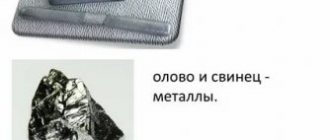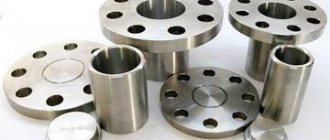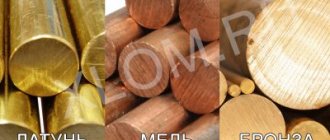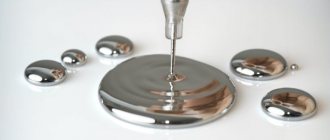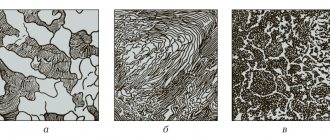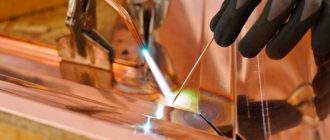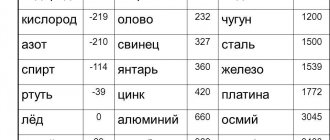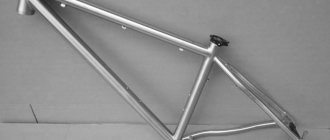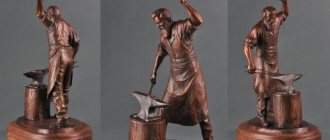Key chemical and physical properties
It is a low-melting (melts already at +325…330℃) bluish-gray metal. It boils at a temperature of about +1750℃. The specific gravity of lead is 11.3 g/m3, which makes it heavier than most known ferrous and non-ferrous alloys. Metal products are distinguished by their flexibility to any mechanical processing: they can be cut, forged, drilled.
Contacting with atmospheric air for just a few hours, the substance acquires on its surface a thin, invisible but highly durable film, which serves as a natural guarantee of the corrosion resistance of lead. Its presence can be determined by some dullness, although if a piece of the substance is broken, cut or chopped, a beautiful shiny surface is exposed, which gradually loses its attractive appearance.
Product manufacturing
It is impossible to obtain pure lead - in nature it occurs in the form of sulfides, sulfates, carbonates, chlorides and other compounds. The raw material for producing metal on an industrial scale is galena or other lead ore (cerussite, anglesite, pyromorphite and other minerals - about 180 items in total, most often polymetallic agglomerates).
The raw material is enriched by flotation or another method, achieving a concentration of the useful component of at least 40%. Then the charge (without treatment or after sintering) is melted down by shaft reduction smelting into rough metal. This substance is an intermediate product with a proportion of the pure base component of about 90%. It continues to be cleaned by subjecting it to zeigerization. The operation is carried out in reverberatory furnaces with an inclined hearth and leads to the division of the total mass of material into fractions - at different melting temperatures.
The resulting semi-finished product is treated with alkali, which allows the purest metal to be isolated.
Its use in construction
Metal is rarely used in construction work: its toxicity limits its range of applications. However, the substance is used in alloys or in the construction of special structures. And the first thing we'll talk about is lead roofing.
Roof
Lead has been used as a roofing material since time immemorial. In Ancient Rus', churches and bell towers were covered with lead sheet, since its color was perfect for this purpose. The metal is plastic, which makes it possible to obtain sheets of almost any thickness, and, most importantly, shape. When covering non-standard architectural elements or constructing complex cornices, lead sheet is simply ideal, so it is used constantly.
Rolled lead is produced for roofing, usually in rolls. In addition to sheets with a standard flat surface, there is also a wavy material - pleated, painted, tinned and even self-adhesive on one side.
In air, the lead sheet quickly becomes covered with a patina consisting of a layer of oxide and carbonates. Patina protects the metal from corrosion. But if for some reason you don’t like its appearance, the roofing material can be coated with a special patination oil. This is done manually or in production conditions.
Sound absorption
Soundproofing a home is one of the enduring problems of old and many modern houses. There are many reasons for this: the structure itself, where walls or ceilings conduct sound, the material of floors and walls that does not absorb sound, innovation in the form of a new elevator design, which is not provided for by the design and creates additional vibration and many other factors. But in the end, the apartment dweller is forced to cope with these problems on his own.
At an enterprise, in a recording studio, or in a stadium building, this problem takes on much larger dimensions, and is solved in the same way - by installing sound-absorbing finishes.
Lead, oddly enough, is used precisely in this role - as a sound absorber. The design of the material is almost the same. A lead plate of small thickness - 0.2-0.4 mm - is covered with a protective polymer layer, since the metal is still classified as dangerous, and organic material is fixed on both sides of the plate - foam rubber, polyethylene, polypropylene. The sound insulator absorbs not only sound, but vibration.
The mechanism is as follows: a sound wave, passing through the first polymer layer, loses some of the energy and excites vibrations of the lead plate. Part of the energy is absorbed by the metal, and the remainder is extinguished in the second foam layer.
It is worth noting that the direction of the wave in this case does not matter.
This video will tell you how lead is used in construction and farming:
X-ray rooms
X-ray radiation is extremely widely used in medicine, essentially forming the basis for instrumental examination. But if in minimal doses it does not pose any particular danger, then receiving a large dose of radiation poses a threat to life.
When setting up an X-ray room, it is lead that is used as a protective layer:
- walls and doors;
- floor and ceiling;
- mobile partitions;
- personal protective equipment - aprons, shoulder pads, gloves and other items with lead inserts.
Protection is provided thanks to a certain thickness of the shielding material, which requires accurate calculations taking into account the size of the room, the power of the equipment, the intensity of use, and so on. The ability of a material to reduce radiation is measured in “lead equivalent” - the thickness of a layer of pure lead that is capable of absorbing the calculated radiation. Protection that exceeds the specified value by ¼ mm is considered effective.
X-ray rooms are cleaned in a special way: timely removal of lead dust is important here, since the latter is dangerous.
Other directions
- One of the most extraordinary uses of metal is the construction of earthquake-resistant foundations and the sealing of masonry joints. Metal has been used in this way since ancient times, but even today this method of imparting vibration resistance to a structure is not outdated.
- Paints containing lead and lead compounds are not used in residential premises. However, they perfectly protect steel and iron from corrosion, so they continue to be used on technical structures: bridges, railway supports, frame structures, and so on.
- Lead-based stabilizers are used in the manufacture of metal-plastic profiles, from which, in turn, windows and doors of various types are made. Leading companies, in light of the trend of abandonment in favor of lead-free technologies, are introducing into production a profile in the production of which lead is not used. However, most manufacturers have not yet abandoned this technology.
Lead is a heavy, malleable, corrosion-resistant metal, and most importantly: accessible and fairly cheap to produce. In addition, metal is indispensable for protection against radiation. So a complete cessation of its use is a matter of a rather distant future.
Elena Malysheva will talk about health problems caused by lead use in the video below:
Common brands
There are several brands of product on the market. The purest grade is C0. It contains 99.992% (by weight) of the base metal, as well as:
- 0.004% bismuth;
- 0.001% iron and zinc each;
- 0.0005% each of tin, copper, antimony, arsenic;
- 0.0003% silver.
The alloy is used to produce semi-finished products for further processing, finished lead products: pipes, sheets, wire.
In second place in terms of purity is the C1C brand with 99.99% lead. The alloy contains the same impurities as option C0, but the concentrations of iron, copper, zinc, silver, antimony are increased to 0.001%, bismuth - to 0.006%. The share of arsenic and tin remains at the same level. Brand C1 is also similar to this compound, but the content of the main substance in it is slightly lower - 99.985%.
The alloys C2C and C2 are even less pure in chemical terms - the bases in them are 99.97% and 99.95%, respectively. The concentration of the base metal in compounds of grades C3C and C3 is 99.5% and 99.9%
Lead alloys
Lead-based alloys. One of the oldest materials. Many metals form eutectics with lead, some metals (mainly alkali and alkaline earth) form stable intermetallic compounds - plumbides (for example, Na2Pb, Mg2Pb, La2Pb), heavy metals - low-melting eutectics (for example, lead-bismuth, lead - cadmium, lead - tin). Lead has a limited tendency to form solid solutions. Lead alloys are characterized by high shock strength. density, low fur. strength, hardness, melting temperature, good anti-friction properties, relatively high acid resistance to dilute sulfuric, sulfuric, chromic, phosphoric, hydrofluoric and some organic compounds. Hydrogen sulfide, sulfur dioxide, sulfuric anhydride, as well as chlorine (at a temperature not exceeding 100 ° C) have practically no effect on alloys. Lead alloys are alloyed with antimony, copper and other metals.
Antimony helps to increase hardness, strength and acid resistance (relative to sulfuric acid); copper slows down recrystallization (reduces segregation) and increases corrosion resistance to sulfuric acid; sodium, potassium, lithium, magnesium, calcium and barium significantly increase hardness, but reduce chemical. durability; cadmium, tin and tellurium increase hardness and fatigue resistance; sodium and arsenic increase the ability to form drops (which is important when casting shot); thallium increases corrosion resistance to organic compounds; bismuth, tin, cadmium, antimony and mercury (in various combinations) significantly lower the melting point.
Lead alloys are divided into antifriction alloys, printing alloys and solders. Lead-based antifriction alloys have a higher hardness and melting temperature than tin-based alloys, and are cheaper (see also Anti-friction materials, Babbitt, tin-bearing Babbitt, Lead-based Babbitt). Typographic alloys based on lead are distinguished by good casting and anti-corrosion properties, low shrinkage and fusibility (tmelt = 240-375 ° C). As alloying additives they contain antimony, which reduces shrinkage during crystallization and increases hardness, and tin, which improves casting properties (see also Low-melting alloys, Printing alloys). Lead-based solders have a wide crystallization temperature range and create stronger joints than other solders (see also Solders). Lead alloys are produced by fusing primary or secondary metals, as well as their alloys.
Alloys of lead with sodium, potassium and calcium are also produced by the electrochemical method - electrolysis of molten salts with a liquid lead cathode. Semi-finished products from S. s. manufactured in the form of ingots (for antifriction and printing products), plates and electrodes (for the chemical industry), rods (for example, for soldering), films (for semiconductor technology), shot (for firearms), etc. .Most alloys are soft and easily give in to fur. processing - rolling, stamping, forging, etc. Anti-friction lead alloys are used for the manufacture of bearings with light and medium loads, bearings for railway cars. Bearings with increased heat resistance are made from thallium-alloyed sulfur. Printing lead alloys are used for the manufacture of stamps, fonts, etc. Solders are used for hermetically sealing parts and for soldering.
Lead alloys alloyed with antimony are used to make dies, battery plates, fan impellers, stirrers, and drums. Lead-tin alloys are used for applying protective coatings. An alloy of lead (45%) with bismuth (55%), which does not shrink, is used in the manufacture of critical models - high-precision castings; an alloy of lead (50%) with bismuth (37.5%) and tin (12.5%) is used to connect glass to metal. An alloy of lead (57%), bismuth (29%) and mercury (14%) melts easily when rubbed. Lead-sodium alloys are used to dry organic liquids, to produce caustic soda and to prepare tetraethyl lead - (C2H5)4Pb, which is added to motor fuel as an anti-knock agent. Lead telluride PbTe, which is a semiconductor, is used in the creation of thermo-, photo- and piezoelectric devices. Thermal generators, in the manufacture of which lead telluride is used, can be operated at a temperature of 650-700 ° C, their efficiency is about 15%.
Lit. Shpagin A.I. Antifriction alloys. M., Fundamentals of Metallurgy, vol. 1.
Article on the topic Lead alloys
Related pages:
- Cadmium alloys CADMIUM ALLOYS Alloys containing cadmium. There are anti-friction, low-melting, precious and special alloys. Anti-friction alloys contain up to 18%...
- Tin alloys (example)
Tin alloys are tin-based alloys that contain other chemical elements that increase or decrease its properties... - Indium alloys
Indium alloys In which indium is the main component or determines their important properties. Used since the 30s. 20th century Indium… - Antimony alloys
Contents of the article1 WHAT ARE ANTIMONY ALLOYS1.1 Alloys based on lead and tin1.2 Application of alloys WHAT ARE ANTIMONY ALLOYS These are alloys... - Zinc alloys
ZINC ALLOYS Zinc-based alloys. The most common alloys of zinc with aluminum and copper, which contain a small amount of magnesium,... - Cerium-containing alloys
WHAT ARE CERIUM-CONTAINING ALLOYS These are alloys that contain cerium. Used since the 20s. 20th century, mostly...
Lead Babbitts
This is a special type of material, which is anti-friction alloys based on lead, additives include copper, antimony and other elements. Their distinctive feature is good workability (the ability to fit rubbing surfaces to each other) and a relatively low melting point. Babbitts are used to fill the bearings of automobile and other transport engines and power units of industrial equipment in order to increase the service life of parts that are subject to significant abrasive loads.
There are several brands of Babbitts on the market. The most common are BS6 with a maximum content of lead and 6% each of antimony and tin, B16 with 6% copper and 9% antimony, BN with the additional inclusion of zinc, bismuth, and nickel. Babbitts are produced from molten primary or secondary metal by adding components to it in accordance with the brand.
Lead alloys,
lead-based alloys
.
There are low-alloyed and high-alloyed carbon dioxide. Group 1 includes alloys containing small additions of Fe, Cu, Sb, Sn, Cd, or Ca in concentrations that do not reduce, and in some cases increase, the corrosion resistance of lead and significantly increase its creep limit and long-term strength. The 2nd group includes lead materials that contain significant quantities of elements that increase strength, hardness, and antifriction properties and lower the melting point of lead and its shrinkage during casting. Like lead, most S. s. (except for those containing more than 0.1% Ca, Mg, Li, K or Na) are characterized by high corrosion resistance in air, water, and most dilute inorganic acids at room and low temperatures. S. s. stable in concentrated acetic, chloroacetic and citric acids. In the presence of oxygen, resistance to organic acids decreases. Chlorine (up to 100 °C), hydrogen sulfide, and sulfur dioxide have a minor effect on S. Low alloyed S. s. very stable in soil containing salts of silicic, carbonic and sulfuric acids.
Of all the elements used to alloy lead, only Ca and Te make it capable of being hardened by plastic deformation. Lead alloyed with other elements due to low recrystallization
softens directly during rolling, pressing, drawing and other processing processes carried out at room temperature. Additives significantly increase the creep strength, long-term strength, recrystallization temperature and resistance of lead in sulfuric acid. With the introduction of 0.05% Te, lead loss under the influence of sulfuric acid is reduced by 10 times.
S. s. with Te (0.03-0.06%), Cu (0.04-0.08%), Sb (0.5-2.0%) are used for the manufacture of sheets, pipes and other semi-finished products, for lining bathtubs and other acid-resistant equipment and pipelines. For the sheaths of low-voltage and power cables, synthetic materials doped with Te (0.04–0.06%), Ca (0.03–0.07%), Sn (1.0–2.0%), and Sb are used. (0.4-0.8%). Low-melting S. s. (see Low-melting alloys
) are mainly double, ternary and more complex eutectics of lead with In, Sn, Bi, Sb, Cd and Hg.
Based on the Pb - Sn, Pb - Ag and Pb - Sn - Sb systems, a series of so-called. soft solders
(with a melting point of 185-305 ° C), characterized by good adhesion to many metals and alloys and high corrosion resistance.
To protect iron alloys from corrosion and before filling bearing shells, lead half-soles, which
are synthetic materials alloyed with 0.5–1% Zn or Sn, are used.
Triple S. s. with Sb (8-23%) and Sn (2-7%) are used in printing technology (see Printing alloys
)
.
Bearing bearings are widely used.
(see Antifriction materials
and
Babbitt
) based on the Pb-Sb-Sn, Pb-Sb-Sn-Cu and Pb-Ca-Na systems.
Due to their high density and good casting properties, steels containing 0.1–1.5% Sb, 0.06–0.2% As, and 0.02–0.04% Na are used for casting shot, and alloys with 0.3-3% Sb for casting bullet cores. Grids for lead batteries
are prepared from Sb containing 6-9% Sb.
Lit.:
Shpichinetsky E. S., Lead alloys, in the book: Handbook of engineering materials, vol. 2, M., 1959.
E. S. Shpichinetsky, G. E. Shpichinetsky.
Table of contents
Metal lead
This is a primary product, a basic semi-finished product for the manufacture of a wide range of metal products. It is purchased by electrical engineering enterprises to produce battery plates and armored cable sheaths. In the production of building materials, lead crushed to powder is added to putties, cement, leveling and other dry mixtures. It is a common additive in paints and an important chemical. In the military industry, the product is required for the manufacture of explosives.
Ingots, ingots
The fundamental difference between these two products is in the shape. The ingot has a strict geometric shape in the form of a parallelepiped or a three-dimensional trapezoid, and the pig has constrictions for convenient division into several parts and ears (also called horns) for ease of transportation and storage.
The products are not used independently, but are raw materials for the manufacture of various products. They are rolled into flat products (sheets and coils), pressed through dies into wire, and pipes are made from them. This lead is suitable for the production of copper alloys, babbitts, solders, and hart (printing) alloys.
Sheet lead
Sheets are produced by hot deformation on a press followed by rolling, during which the product is given the required thickness. The rolled lead is then cut to specified dimensions or subjected to simple edge alignment. To obtain the tape, the pre-made sheet is unraveled on a slitting machine into long strips of the desired width.
Lead sheets are the best material for protecting people, equipment and entire premises from radiation. They are used for wall cladding in X-ray rooms and specialized laboratories. The significant chemical resistance of the metal determines its use as a semi-finished product for corrosion-resistant lining of pipelines and technological equipment in contact with aggressive environments. This is a basic blank for the production of other rolled lead products: rolls (roll-wound strips), pipes.
The tapes are used to make an insulating coating for power and low-current cable products to protect the core from electromagnetic fields. It has high shielding abilities and additionally protects the cable from corrosion.
Flat rolled lead is in demand in nuclear and nuclear power engineering and in the medical industry. Based on the products, you can create an effective screen that prevents the spread of X-rays in the room. Blanks for lead-acid battery plates are cut from them, and in the oil and gas industry, chemistry, petrochemicals and other processing fields, strips and sheets are used to make containers for storing hazardous waste and toxic chemicals. In electroplating, the product coats the walls of working baths for galvanizing, chrome plating, nickel plating and other processes.
Lead-antimony-tin
Repeated attempts have been made to eliminate the disadvantages of Pb-Sb not by eliminating antimony or reducing its content, but by introducing alloying additives. As the latter, in most cases, the same elements that were proposed as additives to metal lead were studied. The greatest effect was obtained with the introduction of tin.
An increase in tin in alloys with a constant antimony content and, conversely, an increase in antimony in alloys with a constant amount of tin leads to an increase in hardness almost proportional to the amount of the alloying element. This pattern of changes in hardness is observed in all states of the alloys studied: cast, quenched and annealed.
Tin is known to form solid solutions with lead and an intermegallide with antimony (SbSn) and is a non-toxic element. In addition, tin promotes depassivation of the current lead-active mass interface, that is, it reduces the contact resistance of the oxide layer. Apparently, tin is incorporated into the oxide layer formed on the surface of the current leads. In this case, the formation of mixed Sn1-xPbxOn crystals is possible, causing an increase in the conductivity of the oxide layer.
In addition, Sn2+, Sn3+ and Sn4+ ions, penetrating into the crystal lattice of PbОn (n<2), change the type of semiconductor conductivity at the specified phase boundary.
The introduction of tin in an amount of less than 0.5% slightly changes the corrosion rate of the low-antimony alloy, while at the same time significantly increases the cohesion of the loose and dense parts of the oxide film formed on the surface of the current leads. An increase in tin concentration, starting from 0.5%, causes a monotonous decrease in the corrosion rate. The minimum tin content at which the alloy has stable characteristics is 2.54-2.7%.
The main disadvantage of Pb-2.5%Sb-3.0%Sn is its tendency to crack during casting. This drawback can be eliminated by casting current leads under pressure, or through additional alloying. The additional element should play the role of a modifier, preventing the formation of a large dendritic α-Pb structure during crystallization, which increases the viscosity of the melt. Selenium can be used as a modifier.
Lead alloy wire
This is a long, solid product in the form of a thread or cord with a round (usually), square or oval (less often) cross-section. It is produced by hydraulic pressing, forcing a thicker workpiece (lead rod) through the holes of the die. Wire is supplied to the consumer in coils or on spools.
The product is actively used in:
- electrical engineering;
- amateur and industrial electronics;
- mechanical and instrument engineering;
- energy sector;
- glass industry.
The thickest modifications are used to seal the joints of tubing in mine shafts, subway openings, and tunnels. Thin versions are used in watchmaking, in the manufacture of medical equipment and fishing equipment (spinners, sinkers).
